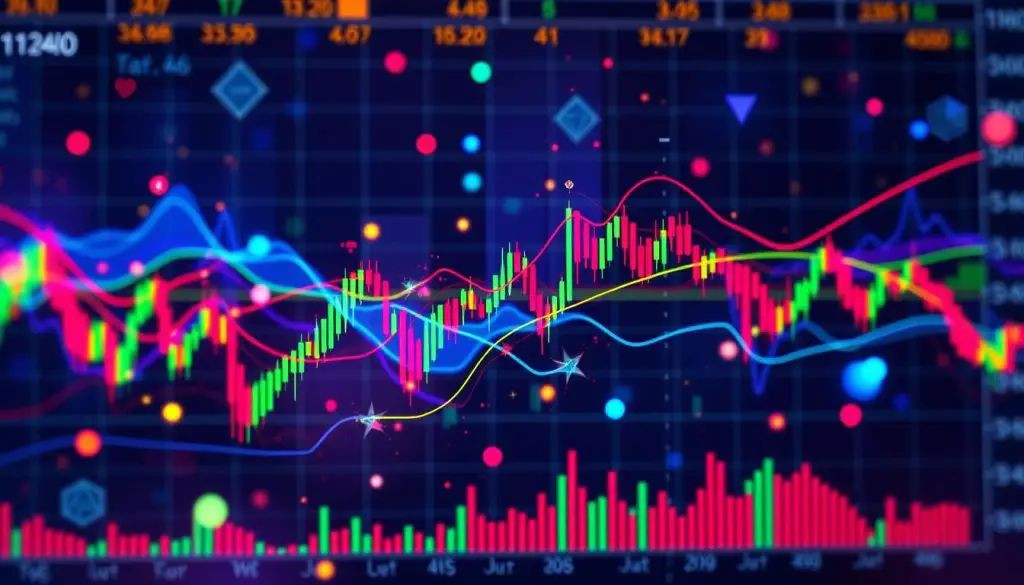Mean reversion trading strategies are key for smart traders looking to grow their portfolios. They use the fact that asset prices often return to their historical average. This can lead to big wins in the stock market.
This article will dive into what mean reversion is and how it works. We’ll look at its theory and how it’s used in real trading. By the end, traders and investors will know how to use these strategies to their advantage.
Understanding Mean Reversion
Mean reversion is when asset prices and returns go back to their usual levels over time. It’s based on the idea that prices that stray far from their average will return to it. This is a key idea in finance.
Definition and Concept
In finance, mean reversion means prices will move towards their average over time. It’s a key idea for traders and analysts. They use it to guess future prices and make smart trades.
Historical Context
The idea of mean reversion started in the 19th century. It shows that financial markets go in cycles. Prices always come back to their usual levels. This led to the creation of many trading strategies.
Real-World Applications
Mean reversion is used in many real-world trading situations. For example, in the stock market, it helps predict price changes. It’s not just for stocks but also for commodities and currencies. This makes mean reversion a valuable tool for traders.
The Importance of Mean Reversion in Trading
Understanding mean reversion can greatly improve trading results. It uses statistical analysis and past data to forecast market trends. This makes it crucial for traders to understand its role in analyzing market behavior and finding profit opportunities.
Market Behavior Analysis
Studying past asset performance is key to market behavior analysis. Mean reversion is a core idea here. It suggests that prices will return to their historical averages. This helps traders make better decisions and time their trades for maximum gain.
Profit Opportunities
Mean reversion trading offers many chances to make money. It works by betting on price corrections after they deviate from the norm. This strategy lowers risks and boosts profits. By using mean reversion and market analysis, traders can spot trends and profit from price swings, leading to steady gains.
Mean Reversion Trading Strategies
Mean reversion trading strategies believe that asset prices always come back to their average. They look for chances to make money when prices are far from their usual levels.
To use these strategies well, traders need tools to find trading signals. These signals show when an asset’s price is off from its usual price, offering a chance to buy or sell. It’s key to spot and use these signals right to do well.
Creating a strong mean reversion strategy means always checking and tweaking it. Traders use past data and test results to improve their predictions. They keep their strategy up-to-date with the market’s changes.
Here’s how different trading signals work in a mean reversion plan:
| Parameter | Strategy | Outcome |
|---|---|---|
| Price Overshoot | Sell | Reversion to the Mean |
| Price Undershoot | Buy | Return to Average Price |
| High Volatility | Adjust Position Sizing | Risk Management |
Building a mean reversion strategy also means studying the market closely. Traders use advanced algorithms or old-school methods to fit their strategies to different markets. This helps them handle big changes better.
Mean reversion trading strategies are based on deep market analysis and smart use of signals. With careful planning and keeping up with market changes, traders can make more money over time.
Key Technical Indicators for Mean Reversion
Mean reversion trading strategies rely on key technical indicators. Moving averages, Bollinger Bands, and the Relative Strength Index (RSI) are crucial. Let’s explore how each indicator works and how they help spot mean reversion trades.
Moving Averages
Moving averages are key in mean reversion strategies. They smooth out price data to show trends clearly. By comparing short-term and long-term averages, traders find overbought or oversold spots. This signals mean reversion opportunities.
Bollinger Bands
Bollinger Bands are vital for mean reversion traders. They include a moving average and upper and lower bands. These bands show price deviations, hinting at mean reversion trades. Bollinger Bands also show volatility and price targets.
Relative Strength Index (RSI)
The Relative Strength Index (RSI) measures price movement speed and change. It ranges from 0 to 100. Readings above 70 mean the price is overbought, and below 30, it’s oversold. These signals help identify mean reversion trades.
Using these technical indicators in a trading strategy boosts success in mean reversion. Knowing how to use moving averages, Bollinger Bands, and RSI is key for consistent success.
Developing a Mean Reversion Trading System
To build a strong mean reversion trading system, you need to know both algorithmic and manual trading. It’s about mixing the accuracy of algorithms with the adaptability of human insight.
Algorithmic Approaches
Algorithmic trading uses computer programs to analyze data and make trades quickly. It’s great for spotting mean-reverting price actions. Traders set rules for these algorithms to work on their own, responding fast to market changes.
- Advantages:
- Speed and Efficiency
- Minimized Human Error
- Consistent Trading Strategies
- Disadvantages:
- Requires Technical Expertise
- High Initial Setup Cost
Manual Trading Techniques
Manual trading lets traders use their gut and experience. It’s good for flexible decisions, especially in unpredictable markets. By watching the market closely and analyzing it in real-time, traders can adjust their plans as needed.
- Advantages:
- Human Intuition and Adaptability
- Lower Upfront Costs
- Disadvantages:
- Time-Consuming
- Higher Risk of Emotional Trading
Today, many traders mix both methods. They use algorithms for quick, efficient trades and manual techniques for making smart, flexible decisions. This mix creates a well-rounded and responsive trading system.
| Approach | Advantages | Disadvantages |
|---|---|---|
| Algorithmic Trading |
|
|
| Manual Trading Techniques |
|
|
The Role of Backtesting Results in Mean Reversion
Understanding historical price behavior is key to finding profitable trades. Backtesting results are crucial here. They help traders see if their mean reversion strategies work. By looking at past data, traders can check if their strategies are reliable and effective.
It’s important to carefully review backtesting results to confirm mean reversion. This step helps improve the strategy for different market conditions. Traders use advanced platforms to test trades and collect data on important metrics.
These platforms give detailed reports on things like win rate, drawdown, and ROI.
Here is an illustrative example of how backtesting results can be summarized:
| Metric | Value |
|---|---|
| Win Rate | 65% |
| Average Return | 8% |
| Drawdown | 10% |
| Profit Factor | 1.5 |
Testing strategies helps weed out those that don’t work in real markets. The goal is to find consistent and reliable mean reversion. This makes trading more profitable and stable over time.
In short, backtesting results are essential for traders to validate and improve their mean reversion strategies. By using these historical insights, traders can trade with more confidence and strategy.
Market Volatility and Mean Reversion
It’s key to grasp how market volatility and mean reversion work together. Volatility can make or break a mean reversion strategy. So, using the right tools to measure it is vital.
Volatility Measures
Tools like the VIX index and standard deviation show how stable the market is. They help traders see when the market is changing a lot. This lets them tweak their plans to fit the market’s mood.
Impact on Strategy Performance
Volatility really shapes how well a mean reversion strategy does. When the market is very volatile, prices jump around a lot. This can lead to false signals.
But, when the market is calm, prices move more predictably. This makes mean reversion strategies work better. By keeping an eye on volatility, traders can make their strategies more effective.
Challenges and Risks of Mean Reversion Trading
Trading with mean reversion strategies comes with its own set of challenges. While it can be profitable, it’s not without risks. It’s important to know and tackle these challenges to succeed in mean reversion trading.
False Signals
One big challenge is dealing with false signals. These happen when the market seems to go back to normal but doesn’t. This can lead to bad trades. To avoid this, traders should analyze carefully and use several indicators to check trends.
Unexpected Market Trends
Another risk is unexpected market trends. Many things can affect the market, like economic news, world events, and how investors feel. These trends can make a mean reversion strategy fail, causing losses. Keeping up with global news and being flexible can help manage these risks.
Managing Risk
Good risk management is key when using mean reversion strategies. Without it, traders can lose a lot. It’s important to set stop-loss orders, have a diverse portfolio, and update trading plans often. Knowing the risks and managing them well can lead to success in mean reversion trading.
FAQ
What is the basic concept behind mean reversion trading strategies?
Mean reversion trading is based on the idea that prices and returns tend to return to their historical average. This can lead to profitable trades by buying undervalued assets or selling overvalued ones.
How has the concept of mean reversion evolved in the stock market?
The idea of mean reversion has grown through detailed stock market studies and finance research. It shows that prices often return to their mean, making it a solid base for trading.
What are some real-world applications of mean reversion?
Mean reversion is used in portfolio optimization and algorithmic trading. Traders use models to find mean-reverting securities and technical indicators for trades. It’s common in hedge funds and financial institutions.
Why is understanding market behavior crucial for mean reversion trading?
Knowing market behavior is key to spotting price deviations from the mean. This helps traders find profit chances, leading to better strategy use.
What are the key technical indicators for detecting mean reversion?
Important indicators include Moving Averages, Bollinger Bands, and the Relative Strength Index (RSI). They signal when prices might revert to their mean, helping traders make trades.
How do algorithmic trading and manual trading techniques differ in mean reversion?
Algorithmic trading uses automated systems for mean reversion, offering speed and precision. Manual trading relies on the trader’s analysis and judgment. Both have their strengths and weaknesses.
What role do backtesting results play in mean reversion trading strategies?
Backtesting results are vital for checking and improving mean reversion strategies. By testing on historical data, traders can refine their strategies for live markets.
How does market volatility impact the performance of mean reversion strategies?
Volatility greatly affects mean reversion strategies. High volatility can lead to bigger trading chances but also raises risk. Traders use volatility measures to adjust their strategies.
What are the common challenges and risks in mean reversion trading?
Mean reversion trading faces challenges like false signals and unexpected trends. These can lead to losses. Effective risk management is key to success.






